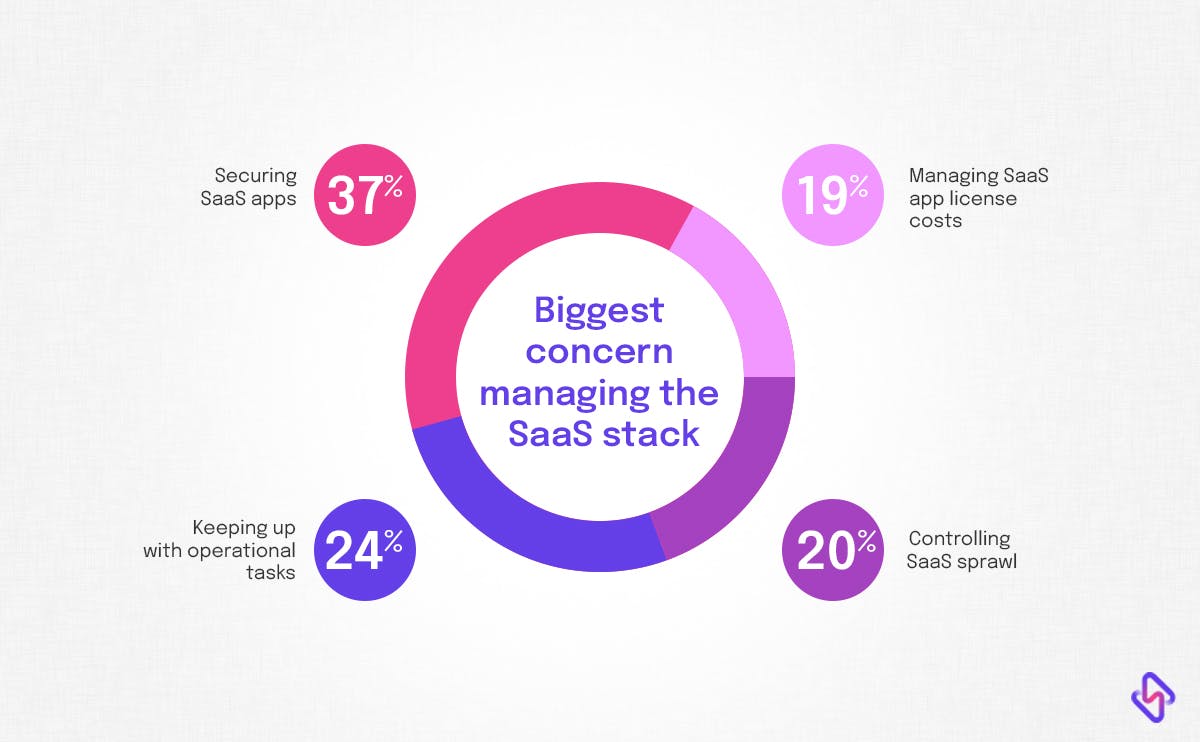In the long run, these challenges pile up, and haunt engineering teams, ramping up technical debt, and killing their productivity.
The Hidden Cost of SaaS Sprawl
A bloated internal app suite is a financial burden to engineering teams. As of now, these teams hold 270+ apps, while spending $4 million annually on their SaaS portfolio.
However, SaaS sprawl doesn’t just impact your company’s bottom line, it also bleeds an enterprise in less direct, but still important ways.
1. Loss of work visibility
ShadowIT (unofficial services that teams use without IT approval) is the major aftereffect of SaaS sprawl that engineering teams are facing today. As of now, shadow SaaS usage is atleast 10x of what IT organizations have ever estimated.
When teams lack a common, centralized toolstack to manage their requirements, they generate knowledge in all these tool spaces.
Combined with a lack of process definition, not only is knowledge scattered, but scarcity of documentation also triggers information deficit, proliferation of tribal knowledge, and an extensive hours of search to find the right resource.
This problem of looking for a needle (task resource) in a haystack (SaaS sprawl) hinders the visibility of what work happens in a team and how to access the product of a team’s efforts.
2. Context Switching and Notification fatigue
When devs are receiving 45 work-related notifications everyday, context switching becomes a natural part of their workflow.
A RingCentral and CITE Research survey of 2000 knowledge workers showed that 7 out of 10 workers waste up to an hour of their workday by simply switching between the different tools they use.
What's more is that 50% of reported developers context switch due to constant information silos, making it difficult to search for resources in the maze of apps.
Do we need any more proof to show the detrimental effect of SaaS sprawl on engineering productivity?
3. Communication Debt, and Collaboration Hurdles
The scattered knowledge and resources, the labyrinth of processes, and the difficulty that developers face in accessing and focusing on tasks forces teams to work synchronously.
Not that sync communications are a team hurdle; they are known to promote team bonding, cohesion, and reduce engineering frictions.
However, synchronous work comes as an engineering bottleneck when teams are frequently dealing with tribal knowledge, with a single point of center for all necessary information, and lacks fundamental digital tool best practices in place.
What might seem like a “quick zoom call to clear doubts”, quickly snowballs into hours of unproductive meetings only to find out where each resource is located, or who is working on what in the team.
The constant connectivity takes a psychological toll on developers, impacting their focus time and deep work.
In the end, ideas are lost, effort goes untracked, and outcomes are subpar.
4. Compromised Security
Currently, the world is using somewhere around 23,000+ SaaS apps. The number becomes critical when global IT teams have begun to highlight how 50% of successful cyberattacks are happening through SaaS use.
The aftershock of SaaS sprawl on enterprise security is pretty much clear. It’s a sign of a developing cyber apocalypse that has the potential to cripple global engineering systems. The issue here isn’t SaaS usage, but an unchecked proliferation of ShadowIT, and deploying SaaS apps without any centralized approval system.
48% of workers use apps that are not distributed by their IT teams.
When any of these apps run into security breaches, it becomes an expensive affair for a company to handle, putting the entire infrastructure, and engineering teams at risk.
During our customer research, we frequently encountered a common scenario where sensitive documents on platforms like Google Docs, Notion, Miro were unintentionally made public, potentially granting access to private data by external individuals.
6. Developer Productivity in Peril
The proliferation of SaaS apps overwhelms the capacity of IT teams, even reducing their ability to keep agile teams functioning across departments.
The rising risk exposure, security breach, and added compliance burden adds to the woes of IT, and engineering teams. Not to mention the time, efforts, and resources involved in introducing, tracking, and integrating new SaaS apps into existing workflows.
When engineering resources are stretched too thin, development teams slows down, the focus to work on core tasks gets constantly hindered, and now developers have no visibility, or understanding of what the other IC are upto. Constantly context switching adds up to the mayhem.
All these consequences work in tandem, and can cause a humongous 80% dip in developer productivity.
It also leaves developers scrambling for clarity over the next steps. As of now, devs are spending 2 hours per day looking for documentation of SaaS use, and to break data silos.
This confusion, and constantly locating information adds to the risk of churning, and developer burnout continues to roil engineering teams.
How To Combat SaaS Sprawl?
As SaaS sprawl grows, engineering leaders must ramp up their efforts to protect their ICs, while improving overall engineering productivity. Here are a few steps teams can take:
1. Regular Software Audits
Regular IT audits to combat Shadow IT, match engineering workflows with a toolstack, understand bottlenecks in adoption, and create a centralized approval system.
An engineering management platform can empower teams to conduct fair, and data-driven SaaS audits. EMPs uses team data to generate contextual reports, and visibility in software adoption, cost, SaaS usage, and even collate developer feedback to understand value created by each app, and ways to remove redundancy.
The platform works like a vertical integration solution supporting teams to choose their preferrable tool belt or app stack.
Async work empowers engineering teams to connect, and collaborate in real-time without hampering their flow state. Allocating focus time slots allows team members to dedicate and direct their attention and effort to cognitively demanding tasks at hand, without getting fatigued by context switching, notification alerts, or an overwhelming SaaS sprawl.
Async work ensures that when a teammate blocks out focus time, other ICs are not depending or blocked on this teammate for their tasks to be completed.
3. Learning From Industry Best Practices
- Implement strong access controls to improve workflow visibility, and clarity into third-party/vendor contracts to uncover Shadow IT
- Adopt a DevOps culture to foster a continuous development, and eliminate tribal knowledge or single POCs for your SaaS apps
- To prevent cloud sprawl, ensure your SaaS service includes cloud-native components so you can continually respond, and manage events both on-prem, and in cloud.
- Design and customize your SaaS governance policy to outline rules and procedures for using any SaaS app in your organization
- Implement a robust license management system. Engineering management platforms usually come with extensions to manage licenses as well. These extensions keep track of licenses in use, their costs, and the renewal dates so you don't overpay.
4. Connector Apps To Reduce Integration Challenges
While uncontrolled SaaS usage is contributing to rising business costs, the industry is experiencing yet another wave of apps to control this proliferation.
Okta, and Bettercloud are already helping IT teams with managing access and automating user provisioning.
Zapier and Integromat help automate everyday work from creating tickets (think Jira tickets for bug reports) to integrating leads in a CRM.
To reduce data discovery silos, Elastic Workplace Search integrates knowledge into a centralized system to facilitate ease of search across toolstack.
Manage SaaS Sprawl With Engineering Analytics
As businesses adapt to the changing landscape of work after the pandemic, engineering leaders are carefully plotting their strategies to thrive in this new reality. Their goal is to ensure success and reduce disruptions in an uncertain economy.
And that’s where using an engineering analytics platform becomes critical– using contextual data from their digital exhaust to drive strategic decision-making.
Work analytics platforms like Hatica empower engineering leaders to gain workflow visibility, and improve long-term developer productivity and engagement, all without forceful downsizing your SaaS usage.






